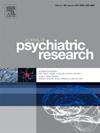评估自然语言处理衍生的与当前自杀意念、过去自杀企图和未来自杀行为相关的语言特征
IF 3.7
2区 医学
Q1 PSYCHIATRY
引用次数: 0
摘要
精神病患者比一般人群有更高的自杀风险。自然语言处理(NLP)已被用于理解精神病患者的沟通和自杀风险预测,但尚未用于预测精神病患者未来的自杀行为。我们利用从精神障碍患者的二元任务中获得的nlp衍生语言特征来预测当前的自杀意念、过去的自杀企图和未来的自杀行为。方法112例成人精神障碍患者在基线和1年随访期间完成哥伦比亚自杀严重程度评定量表,记录其终生自杀企图、当前自杀意念和自杀行为。在基线阶段,参与者完成了一项名为“社会技能表现评估”的二元角色扮演任务。从任务文本中提取词汇特征、词汇多样性特征和情感特征。每个结果的模型使用MLPRegressor的70% - 30%训练测试分割生成。采用SHapley加性解释(SHAP)进行特征分析。结果在1年随访中,共有42.9%的参与者有基线自杀意念,67.9%的参与者至少有过一次自杀企图,13.3%的参与者至少有一次新的自杀行为。这些模型对过去自杀行为(F1 = 0.75)和当前自杀行为(F1 = 0.74-0.79)具有较强的预测能力,其中对未来自杀行为的预测能力最强(F1 = 0.86-0.93)。最重要的特征包括自杀意念、过去的尝试和未来的行为。二元任务的nlp衍生特征与未来自杀行为的高预测准确性相关。有待验证的是,这些发现表明,来自二元任务的nlp衍生语言特征可能有助于理解精神病患者的自杀风险。本文章由计算机程序翻译,如有差异,请以英文原文为准。
Evaluating natural language processing derived linguistic features associated with current suicidal ideation, past attempts, and future suicidal behavior
Background
People with psychosis have a higher suicide risk than the general population. Natural language processing (NLP) has been used to understand communication in psychosis and suicide risk prediction, but not to predict future suicidal behavior in people with psychosis. We utilized NLP-derived linguistic features from a dyadic task among people with psychotic disorders to predict current suicide ideation, past suicide attempts, and future suicidal behavior.
Methods
N = 112 adults with psychotic disorders completed the Columbia-Suicide Severity Rating Scale at baseline and one-year follow-up to capture lifetime suicide attempts, current suicidal ideation, and suicidal behavior during the follow-up period. At baseline, participants completed a dyadic role-play task called the Social Skills Performance Assessment. Lexical features, lexical diversity, and sentiment features were extracted from task transcripts. Models for each outcome were generated using a 70 %–30 % train-test split with MLPRegressor. SHapley Additive exPlanations (SHAP) was utilized for feature analysis.
Results
A total of 42.9 % of participants had baseline suicidal ideation, 67.9 % had at least one past suicide attempt, and 13.3 % had at least one reported new suicidal behavior at one-year follow-up. The models had strong predictive performance for past attempts (F1 = 0.75) and current ideation (F1 = 0.74–0.79), with future suicide behavior models showing the strongest predictive performance (F1 = 0.86–0.93). The top features varied across suicide ideation, past attempts, and future behavior.
Discussion
NLP-derived features from a dyadic task were associated with high predictive accuracy for future suicidal behavior. Pending replication, these findings suggest that NLP-derived linguistic features from dyadic tasks could contribute to understanding suicide risk among people with psychosis.
求助全文
通过发布文献求助,成功后即可免费获取论文全文。
去求助
来源期刊

Journal of psychiatric research
医学-精神病学
CiteScore
7.30
自引率
2.10%
发文量
622
审稿时长
130 days
期刊介绍:
Founded in 1961 to report on the latest work in psychiatry and cognate disciplines, the Journal of Psychiatric Research is dedicated to innovative and timely studies of four important areas of research:
(1) clinical studies of all disciplines relating to psychiatric illness, as well as normal human behaviour, including biochemical, physiological, genetic, environmental, social, psychological and epidemiological factors;
(2) basic studies pertaining to psychiatry in such fields as neuropsychopharmacology, neuroendocrinology, electrophysiology, genetics, experimental psychology and epidemiology;
(3) the growing application of clinical laboratory techniques in psychiatry, including imagery and spectroscopy of the brain, molecular biology and computer sciences;
 求助内容:
求助内容: 应助结果提醒方式:
应助结果提醒方式:


